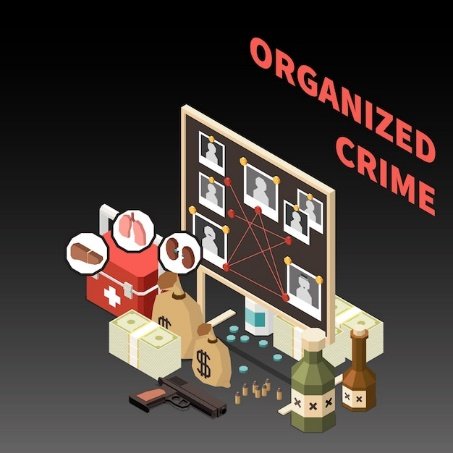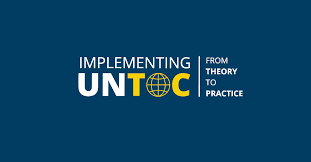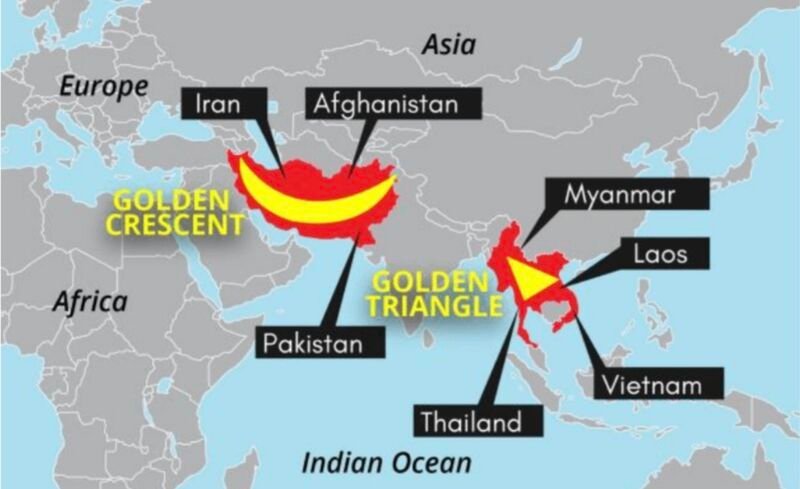Linkages of Organized Crime with Terrorism
- Understanding Organized Crime
- Terrorism
- Types of Terrorism
- Means/Methods of Terrorism
- Difference Between Extremism and Terrorism
- Impact of Terrorism
- Key Funding Mechanisms of Terrorism
- Linkages Between Organized Crime and Terrorism
- Similarities Between Organized Crime and Terrorism
- Impact of Organized Crime on National and International Security
- Legal and Policy Frameworks
- International Cooperation
- Challenges in combating organized crime and terrorism
- Way Forward
- Conclusion
- FAQs related to Linkages of Organized Crime with Terrorism

In recent times, the collaboration between the two has deepened—terrorist groups often rely on criminal networks for funding, logistics, and arms, while organized crime benefits from the protection and destabilization provided by terrorism. This convergence complicates global security frameworks, blurring the lines between law enforcement and counterterrorism, and calls for unified, cross-border strategies to tackle the dual threat.
Understanding Organized Crime
Organized crime refers to criminal syndicates that operate with a high degree of structure, coordination, and secrecy. These groups engage in various illegal activities to amass profits, often utilizing violence, corruption, and global networks to maintain control and evade law enforcement. Unlike spontaneous or individual crimes, organized crime is a long-term, strategic enterprise that involves a wide range of illicit operations.
Key Characteristics of Organized Crime
- Hierarchical Structure: Organized crime groups have a well-defined leadership hierarchy, from bosses to underbosses, ensuring discipline and efficient execution of criminal activities.
- Diverse Illicit Activities: These groups engage in activities such as drug trafficking, human trafficking, arms smuggling, money laundering, extortion, and cybercrime, generating significant illicit profits.
- Use of Violence and Intimidation: Violence, including murders and kidnappings, is used to enforce control, eliminate threats, and protect their operations.
- Corruption and Influence: They exploit corruption within governments, law enforcement, and businesses to facilitate their operations and avoid detection or prosecution.
- Global Reach and Networks: Many organized crime syndicates operate internationally, trafficking goods and controlling vast criminal networks that span multiple countries.
- Money Laundering: Money laundering is a key strategy for legitimizing illicit profits, utilizing shell companies, real estate, and offshore accounts to integrate illegal gains into the legal economy.
Types of Organized Crime
Organized crime manifests in various forms, often adapting to new opportunities and vulnerabilities in society. These criminal enterprises are structured, well-funded, and frequently operate across national borders. Below are the major types of organized crime, presented in a mix of paragraph and point format for clarity: 
- Drug Trafficking: Involves the illegal production, transportation, and sale of narcotics. It is one of the most profitable and widespread forms of organized crime globally.
- Human Trafficking: Exploits vulnerable individuals for forced labor, sexual exploitation, or organ trade. Victims are often trafficked across borders and stripped of basic rights.
- Arms Smuggling: Refers to the illegal trade in weapons and ammunition, often linked to terrorism and insurgencies, thereby fueling global conflicts.
- Money Laundering: A process to legitimize money obtained from criminal activities by passing it through legal financial systems, weakening economic transparency.
- Cybercrime: Includes hacking, online fraud, identity theft, and ransomware attacks. It is rapidly expanding with digitalization and often involves organized groups.
- Extortion and Racketeering: Involves the use of threats or violence to extract money or control businesses, commonly associated with mafia networks.
- Counterfeiting: Production and distribution of fake currency, goods, or documents, which harms economies and can put consumers at risk.
- Environmental Crime: Encompasses illegal activities like poaching, illegal logging, and hazardous waste dumping, threatening biodiversity and public health.
These interconnected crimes often operate under the radar and require coordinated global efforts to combat their growing influence.
|
Transnational Organized Crime (TOC) |
| Transnational Organized Crime (TOC) involves criminal activities carried out by organized groups across national borders, driven by profit, power, or influence. These crimes exploit weak governance, porous borders, and globalization, posing a significant challenge to global security. The Palermo Convention (2000) serves as the primary international framework to combat TOC, which includes a range of illicit activities such as drug trafficking, human trafficking, arms smuggling, and cybercrime.
The major types of TOC include drug and human trafficking, arms smuggling, money laundering, wildlife and environmental crime, maritime piracy, and cultural property trafficking. These crimes weaken states, fuel corruption, and often provide financial support to terrorism. Addressing TOC requires strong international cooperation, intelligence sharing, and effective enforcement mechanisms to prevent its spread and mitigate its impact on global peace and security. |
Factors Responsible for Exacerbating Organized Crime
Organized crime thrives when systemic, social, economic, and political vulnerabilities are exploited. Various interlinked factors have contributed to its rise and expansion, both within national borders and across them.
- Weak Governance and Corruption: Ineffective law enforcement, judicial delays, and corrupt officials enable criminal networks to flourish.
- Globalization: Ease of cross-border movement, trade, and digital communication allows crimes to spread transnationally.
- Porous Borders: Unregulated or poorly monitored borders facilitate smuggling of drugs, arms, and people.
- Political Instability and Conflict: War zones and failed states create power vacuums exploited by criminal syndicates.
- High Unemployment and Poverty: Vulnerable populations are often drawn into organized crime due to lack of economic opportunities.
- Demand for Illegal Goods/Services: High demand for drugs, trafficked humans, wildlife, etc., sustains black markets.
- Technological Advancements: Use of encrypted communication, darknet, and cryptocurrencies helps criminals evade detection.
- Lack of International Coordination: Jurisdictional issues and lack of unified legal frameworks hinder cross-border enforcement.
Challenges in Combating Organized Crime 
Despite national and international efforts, organized crime remains a persistent threat. Multiple structural, legal, and operational challenges hinder effective response and prevention mechanisms.
- Lack of International Coordination: Absence of unified legal frameworks and cooperation hampers cross-border operations.
- Jurisdictional Barriers: Criminals exploit gaps between national legal systems, making prosecution difficult.
- Political Corruption: Links between criminal syndicates and politicians/police dilute enforcement.
- Advanced Technology: Criminals use encrypted apps, darknet, and cryptocurrencies to stay anonymous.
- Resource Constraints: Law enforcement agencies often lack adequate training, manpower, or funds.
- Infiltration into Legitimate Business: Organized groups often launder money through legal enterprises, making detection hard.
- Slow Judicial Process: Delays in prosecution and weak witness protection reduce conviction rates.
- Public Apathy and Fear: Fear of retaliation and mistrust in police discourage reporting of organized crime.
Measures to Combat Organized Crime
Organized crime poses a significant threat to society, economies, and governance. It encompasses various illegal activities, such as drug trafficking, human trafficking, arms smuggling, cybercrime, and money laundering. Combating organized crime requires a comprehensive and multi-faceted approach.
- Strengthening Law Enforcement Agencies: Specialized units, such as anti-narcotics and anti-money laundering teams, should be established within law enforcement agencies to combat organized crime effectively. These units should be equipped with modern technology and ongoing training to tackle sophisticated criminal activities.
- Enhanced Legislation and Legal Reforms: Governments must implement robust legal frameworks to address organized crime, including harsher penalties for offenders and laws that specifically target organized crime groups, human trafficking, and terrorism financing.
- International Cooperation and Coordination: Criminals often operate across borders, so international cooperation is crucial. Organizations like INTERPOL, UNODC, and regional bodies facilitate cross-border cooperation, intelligence sharing, and joint operations to dismantle criminal networks.
- Targeting Criminal Finances: Disrupting the financial operations of organized crime is critical. Anti-money laundering (AML) laws, financial monitoring, and asset forfeiture measures can help trace and seize ill-gotten wealth, weakening criminal syndicates.
- Witness Protection Programs: To ensure successful prosecutions, authorities should establish robust witness protection programs. These programs provide protection and anonymity for witnesses who testify against criminal organizations, making it harder for criminals to intimidate or eliminate potential informants.
- Public Awareness and Community Engagement: Raising awareness about the dangers and impact of organized crime through community outreach programs can help prevent people from becoming involved. Collaboration with local communities strengthens trust in law enforcement and facilitates the identification of criminal activities.
- Disrupting Criminal Networks with Technology: The use of cutting-edge technology, such as surveillance tools, data analysis, and cyber forensics, can help law enforcement identify and dismantle organized crime groups. Technology also enables better coordination between agencies and international partners.
- Addressing Socio-Economic Factors: Tackling the root causes of organized crime, such as poverty, unemployment, and lack of education, can prevent vulnerable individuals from being drawn into criminal organizations. Government policies that focus on economic development and social welfare play a crucial role in this regard.
By implementing these measures, society can take significant strides toward eradicating organized crime and safeguarding public order and justice.
Terrorism 
The term “terrorism” originated during the Reign of Terror in France (1793–1794), a period of intense political upheaval following the French Revolution. It was associated with state-sponsored violence used to instill fear among the public and suppress opposition.
Post World War II, the nature and geographical focus of terrorism shifted:
- Earlier concentrated in Europe, it gradually spread to Asia, Africa, and the Middle East.
- The motivations behind terrorism evolved—from ideological and nationalist goals to religious fundamentalism, ethnic identity, and state-sponsored objectives.
- Modern terrorism has become more transnational and networked, using technology and global platforms for coordination and propaganda.
Definition of Terrorism
There is no universally accepted definition of terrorism due to varying political perspectives, strategic interests, and ideological biases.
| Broadly, terrorism refers to: “The use of violence or threat of violence, often targeting civilians, to instill fear and achieve political, religious, or ideological objectives.” |
Efforts to define terrorism internationally have faced several obstacles:
- Perception gap: A “terrorist” to one country may be seen as a “freedom fighter” by another.
- State actors’ involvement: Some states support or sponsor terrorism for strategic goals (e.g., Pakistan’s ISI involvement in Kashmir).
- Lack of political will among nations to agree on a common legal framework.
- Multiplicity of definitions: Hundreds of definitions exist globally, reflecting the complexity of the issue.
India’s Attempt: Comprehensive Convention on International Terrorism (CCIT)
- India proposed the CCIT at the UN in 1996 to develop a universal legal definition of terrorism and to criminalize all forms of support for terrorism, including finance, training, and sanctuary.
- The proposal aims to create a comprehensive legal framework to combat terrorism globally.
- However, it has remained deadlocked in the 6th Committee of the UN General Assembly due to disagreements over:
- Inclusion of state-sponsored terrorism
- Exemptions for “liberation movements”
India has repeatedly pressed for adoption, especially after major global attacks like the 2016 Dhaka terror attack.
| UN Academic and Crime Branch Definitions |
|
Types of Terrorism
Terrorism can be classified on the basis of motivation, objectives, and the methods adopted by terrorist groups. This classification helps in understanding their nature, purpose, and operational strategy.
- Ethno-Nationalist Terrorism – Violence carried out by ethnic or regional groups demanding a separate state or dominance of their identity over others. Examples: LTTE in Sri Lanka, ULFA and NSCN in North-East India.
- Religious Terrorism – Violence justified in the name of religion, considering it a sacred duty to carry out acts of terror. Examples: ISIS, Al-Qaeda, Jehadi Terrorism in Kashmir.
- Ideology-Oriented Terrorism – Terrorism driven by political, social, or economic ideologies to challenge the existing system.
- a) Left-Wing Terrorism – Opposing capitalism and social inequality using violence for revolutionary change. Examples: Naxalites, Maoists in India, Red Army Faction (Germany).
b) Right-Wing Terrorism – Aimed at preserving traditional values, religion, or nationalism, often using violence against perceived threats. Examples: Nazi Party (Germany), Ku Klux Klan (USA), White Supremacist Groups. - State-Sponsored Terrorism – Terrorism supported directly or indirectly by a nation-state to destabilize rival countries for strategic gains. Examples: Pakistan’s ISI support to terrorism in Kashmir, Iran and North Korea supporting militant groups.
- Narco-Terrorism – The use of drug trafficking profits to fund terrorism or the use of terror tactics to control drug trade routes and markets. Examples: Colombian and Peruvian drug cartels, Taliban’s involvement in Afghanistan’s opium trade, Terrorist groups in Kashmir linked with drug trafficking.
Means/Methods of Terrorism
Terrorist groups adopt various means and methods to spread fear, maximize destruction, and achieve their objectives, often evolving with technological advancements.
- Environmental & Eco-Terrorism – Causing deliberate environmental destruction or attacking industries harming nature to instill fear, e.g., 1991 Gulf War oil well fires, attacks on mining projects.
- Suicide Terrorism – Attacks carried out by individuals willing to die during operations for maximum impact, e.g., LTTE suicide bombers, Fedayeen attacks in Kashmir, 26/11 Mumbai attack.
- Rocket and Mortar Attacks – Use of explosive projectiles like rockets and mortars to target civilian or military areas from a distance, e.g., Palestinian rocket attacks on Israel, mortar shelling in Kashmir.

- Drone Attacks – Use of UAVs/drones loaded with explosives for remote attacks on security installations and infrastructure, e.g., 2021 Jammu air base attack, Houthi drone strikes on Saudi oil facilities.
- Weapons of Mass Destruction (WMDs) – Use of chemical, biological, or nuclear weapons to cause large-scale death and destruction, e.g., Sarin gas attack in Tokyo, Anthrax use, nuclear threats.
- Agro-Terrorism – Targeting crops, livestock, or agricultural infrastructure to create food insecurity and economic losses, e.g., spreading animal diseases, poisoning livestock water
- Cyber Terrorism – Attacks on computer networks and digital infrastructure for disruption or propaganda, e.g., 2007 Estonia cyber-attack, hacking Indian defence systems, dark web terror financing.
Difference Between Extremism and Terrorism
While often used interchangeably, extremism and terrorism are distinct concepts in the realm of internal security and political violence. Understanding their difference is essential for policymaking, legal action, and academic clarity.
| Aspect | Extremism | Terrorism |
| Definition | Holding radical, fanatical, or uncompromising views or ideologies. | The use of violence or the threat of violence to achieve political, religious, or ideological objectives. |
| Nature | Ideological or belief-based; may not involve violence. | Always violent or threatening in nature. |
| Means | Spreading radical ideas, hate speech, propaganda, or inciting violence. | Use of bombings, shootings, kidnappings, hijackings, etc. to create fear. |
| Legality | May fall under freedom of expression, unless it incites violence. | Clearly illegal and criminal under national and international law. |
| Threat Level | Poses a potential threat if it incites violence or discrimination. | Poses a direct threat to life, property, public order, and national security. |
| Example | Justifying religious supremacy without acting violently. | Planting a bomb in a public place to advance a political cause. |
| Relationship | Can be a precursor to terrorism if not addressed. | Often rooted in extremist ideology, but not all extremists become terrorists. |
Impact of Terrorism
Terrorism has multi-dimensional impacts on a country’s security, economy, social fabric, and overall development, creating long-term instability and fear.
- Threat to National Security – Directly challenges the unity, integrity, and sovereignty of the nation, promoting separatism, cross-border terrorism, and internal disturbances.
- Law and Order Problems – Increases violence, insurgency, and criminal activities, putting heavy pressure on security forces, police, and intelligence agencies.
- Economic Losses – Leads to destruction of infrastructure, reduction in foreign investment, rising defence expenditure, disruption of trade, tourism, and business activities.
- Communal Tensions and Social Division – Disturbs communal harmony, creates mistrust among communities, increases polarization, and weakens the social fabric.
- Radicalization of Youth – Propaganda by terrorist groups leads to ideological radicalization, recruitment, and involvement of youth in extremist activities.
- Psychological Impact on Society – Creates fear, trauma, and insecurity among citizens, with long-lasting mental health issues for victims, survivors, and affected populations.
- Rise in Organized Crime – Promotes illegal activities like arms smuggling, drug trafficking, counterfeit currency, and human trafficking linked to terror financing.
- Weakening of Governance and Institutions – Undermines public confidence in government, diverts resources from development to security, and challenges law enforcement capabilities.
Terrorism not only causes loss of life and property but also weakens the very fabric of society by promoting fear, division, and lawlessness. Combating terrorism requires a multi-dimensional approach focusing on security, economy, social harmony, and deradicalization efforts.
| Encounters against Terrorists |
Encounters or extra-judicial killings have been a controversial method used by security forces in counter-terrorism operations in India. While often projected as necessary for national security, many cases have raised serious questions about human rights violations and fake encounters.
Encounters continue to evoke debates between the need for swift action against terrorism and the protection of human rights and due process of law. |
Key Funding Mechanisms of Terrorism
Terrorist organizations use diverse and evolving methods to generate financial resources required for their operations, recruitment, logistics, and propaganda.
- State Sponsorship – Financial, military, and logistical support provided by nation-states that align with terrorist groups ideologically or strategically.
- Donations and Charities – Collection of funds from sympathizers and supporters worldwide, often routed through charity organizations and NGOs to avoid detection.
- Criminal Activities – Engagement in organized crime like drug trafficking, human trafficking, extortion, robbery, and arms smuggling to generate substantial profits.
- Illegal Trade and Smuggling – Involvement in black market trade of oil, precious stones, counterfeit goods, wildlife products, and antiquities to fund operations.
- Kidnapping for Ransom – Abduction of individuals, especially foreigners or high-value targets, to demand ransom money for financing terror activities.
- Cybercrime – Use of online fraud, phishing, hacking, identity theft, and cryptocurrency scams to generate anonymous and untraceable funds.
- Self-funding by Members – Reliance on personal savings, small-scale loans, crowdfunding, or financial contributions from individual members to finance terror plots, especially in lone-wolf or sleeper cell attacks.
| Golden Triangle and Golden Crescent |
| Golden Triangle refers to a region in Southeast Asia where the borders of Thailand, Laos, and Myanmar meet. It has historically been one of the world’s largest opium-producing areas. The combination of rugged terrain, ethnic insurgencies, and weak state control has made it a hotspot for illicit drug cultivation and trafficking. This region plays a significant role in the global heroin trade and is often linked to organized crime and internal security issues.
Golden Crescent, on the other hand, is a region in Southwest Asia comprising Afghanistan, Iran, and Pakistan. Afghanistan alone produces over 80% of the world’s opium, making this area the most significant source of illicit opiates. The narcotics trade in this region is deeply intertwined with terrorism financing, insurgency operations, and corruption, posing serious challenges to regional and global security. |
Linkages Between Organized Crime and Terrorism
Organized crime and terrorism, while distinct in motives—profit vs ideology—often converge in operations, logistics, and financing. This convergence creates a powerful nexus that amplifies their reach and undermines global security efforts.
- Financial Support and Resource Sharing – Terrorist groups rely on organized crime for funding through drug trafficking, money laundering, and arms smuggling, gaining resources essential for their operations.
- Mutual Benefit in Illicit Markets – Both entities profit from shared illegal enterprises like drug trade, human trafficking, and weapons smuggling, forming a symbiotic relationship that enhances each other’s capabilities.
- Cross-Border Operations – Weak governance and porous borders allow both groups to collaborate in smuggling people, weapons, and contraband while avoiding detection across multiple jurisdictions.
- Recruitment and Networking – Criminal networks provide skilled recruits and logistical support to terrorists, leveraging their experience in illegal activities to carry out complex attacks.
- Diversion of Law Enforcement Resources – The dual threat strains security forces, as combating organized crime and terrorism simultaneously divides focus and weakens overall enforcement effectiveness.
- Weapons and Technology Transfer – Organized crime syndicates supply arms and technology, including explosives and secure communications, which terrorist groups use to expand their operational reach.
- Terrorist Financing through Criminal Activities – Illicit activities like extortion, piracy, and fraud serve as funding channels for terrorism, complicating financial tracking and disrupting global anti-terror efforts.
- Shared Ideology of Disruption and Violence – Despite differing goals, both seek to destabilize state institutions and exploit lawlessness, often aligning in their opposition to legal and political systems.
The convergence between organized crime and terrorism creates a resilient, adaptive threat that is difficult to dismantle. Disrupting this nexus requires an integrated, intelligence-driven approach that targets their financial networks, logistical chains, and operational collaborations simultaneously.
Similarities Between Organized Crime and Terrorism
Organized crime and terrorism are two major threats to national and international security. While their ultimate goals may differ — profit for organized crime and ideology for terrorism — they share several operational and structural similarities. Below are key similarities between the two:
| Aspect | Similarity |
| Structure | Both have hierarchical, networked, or cell-based structures that enable secrecy, coordination, and control. |
| Use of Violence | Both employ violence, intimidation, and threats to achieve their goals — either to instill fear (terrorism) or control territories and markets (organized crime). |
| Secrecy and Clandestine Operations | Both operate underground, using codes, covert meetings, and encrypted communications to evade detection. |
| Corruption and Infiltration | Both use corruption to influence politicians, law enforcement, and judiciary systems to protect their operations. |
| Funding through Illicit Means | Both engage in illegal activities like drug trafficking, smuggling, extortion, and arms dealing to generate funds. |
| Exploitation of Weak States | Both thrive in regions with weak governance, political instability, poor law enforcement, and porous borders. |
| Transnational Nature | Both can operate across national boundaries and use global networks for movement of people, goods, and money. |
| Use of Technology | Both utilize advanced technology for planning, propaganda (terrorism), financial transactions, and evasion of surveillance. |
These similarities often lead to a nexus between organized crime and terrorism, making it critical for policymakers to adopt integrated strategies to combat both threats simultaneously.
| Case Studies of Organized Crime and Terrorism Linkages |
The linkages between organized crime and terrorism are evident in numerous real-world scenarios. These connections not only complicate efforts to combat both forms of crime but also highlight the adaptability and resilience of these groups. Several case studies demonstrate how criminal and terrorist organizations collaborate, leading to amplified threats to global security.
|
Impact of Organized Crime on National and International Security
Organized crime is no longer confined within national boundaries; it poses a significant challenge to both domestic stability and international peace. It weakens governance, fuels corruption, promotes violence, and threatens economic and social structures globally.
Impact on National Security
- Undermining the Rule of Law – Organized crime weakens the authority of state institutions by infiltrating law enforcement, judiciary, and politics, leading to loss of public trust and increased lawlessness.
- Encouraging Corruption – Criminal groups bribe officials and politicians, enabling their operations and diverting government resources away from public welfare to protect illegal activities.
- Increasing Violence and Instability – Turf wars, extortion, contract killings, and intimidation tactics by organized crime syndicates create a climate of fear, disrupting peace and public life.
- Funding Terrorism and Insurgency – Organized crime networks provide financial and logistical support to terrorist and insurgent groups through drug trade, arms smuggling, and human trafficking.
- Destabilizing Economies – Activities like money laundering, fake currency circulation, and smuggling harm economic growth, reduce investor confidence, and promote parallel black economies.
Impact on International Security
- Transnational Criminal Networks – Global expansion of organized crime has created complex international networks that facilitate the movement of drugs, arms, money, and people across borders, complicating law enforcement efforts.
- Threatening Global Trade and Borders – Smuggling and trafficking by crime syndicates compromise international trade, border security, and customs systems, disrupting legal trade channels.
- Fostering Regional Conflicts – In conflict-prone or weak governance areas, organized crime collaborates with insurgent or terrorist groups, intensifying regional instability and obstructing peace efforts.
- Humanitarian Impact – Human trafficking, forced labor, drug abuse, and exploitation of vulnerable populations by crime networks cause large-scale human rights violations and burden international humanitarian systems.
Organized crime poses a multi-dimensional threat to both national and international security. It not only undermines state authority and economic stability but also strengthens terrorism and insurgency. Tackling this challenge demands comprehensive strategies combining robust domestic laws, international cooperation, intelligence sharing, and capacity building to safeguard governance, economy, and human security worldwide.
Legal and Policy Frameworks
The growing linkages between organized crime and terrorism demand a strong legal and policy response at national and international levels. Effective frameworks must target financing, operations, and support systems of both these threats while ensuring cross-border cooperation and preventive measures.
Legal Frameworks
- Anti-Money Laundering (AML) Laws – Laws that mandate financial institutions to track and report suspicious transactions to prevent funds from reaching terrorist and criminal networks.
- Counter-Terrorism Financing (CTF) Legislation – Laws that prohibit financial support to terrorist entities, enabling asset freezing, blacklisting of organizations, and criminalizing terror financing activities.

- International Conventions and Protocols – Instruments like UNTOC and the International Convention for the Suppression of the Financing of Terrorism provide a global legal framework for cooperation in tackling cross-border crime and terrorism.
- National Counter-Terrorism Laws – Domestic laws empowering law enforcement agencies with surveillance, preventive detention, and special investigation powers against terror and crime networks.
- Cybercrime and Cybersecurity Laws – Laws addressing cybercrimes like hacking, online fraud, cyberterrorism, and securing critical infrastructure from digital attacks by criminal or terrorist groups.
Policy Frameworks
- Integrated Law Enforcement Strategies – Policies promoting coordination between police, intelligence, border security, and customs to dismantle terror-crime networks through joint task forces and shared operations.
- Regional and International Cooperation – Promoting collaboration through MLATs, Interpol, FATF, and UNODC to ensure criminals and terrorists cannot exploit international borders for safe havens.
- Strengthening Border Security and Immigration Control – Policies for smart border management using biometric systems, surveillance technology, and strict immigration controls to prevent cross-border crimes.
- Intelligence Sharing and Data Integration – Policies encouraging real-time intelligence exchange and database integration among domestic and international agencies for timely action.
- Public Awareness and Counter-Radicalization Programs – Initiatives targeting vulnerable populations to prevent radicalization, recruitment, and involvement in criminal or terrorist activities.
- Comprehensive Criminal Justice System – Strengthening investigation capacity, ensuring speedy trials, training law enforcement, and plugging legal loopholes for effective prosecution of crime-terror linkages.
International Cooperation
Organized crime and terrorism are transnational threats that transcend borders, making international cooperation vital for effectively countering them. Through treaties, shared intelligence, joint operations, and mutual legal frameworks, countries can coordinate their actions to dismantle these global networks.
- Bilateral and Multilateral Agreements – Treaties like the UN Convention against Transnational Organized Crime (UNTOC) and regional frameworks such as the EU Counter-Terrorism Strategy create legal foundations for joint operations, standardizing laws and enabling cooperation across borders.
- Intelligence Sharing and Joint Task Forces – International bodies like Interpol, Europol, and UNODC facilitate real-time exchange of intelligence. Joint task forces comprising agencies from multiple countries work together on threats such as trafficking, terror financing, and arms smuggling.
- Financial Cooperation and AML Efforts – Institutions like the Financial Action Task Force (FATF) help countries enforce global anti-money laundering standards. Collaboration among banks, governments, and financial regulators is key to tracking illicit funds used by criminal and terror groups.

- Extradition and MLATs – Mutual Legal Assistance Treaties (MLATs) and extradition agreements enable countries to prosecute criminals hiding across borders. They facilitate evidence sharing, witness examination, and legal cooperation in combating cross-border crimes.
- Role of International Organizations – Platforms such as the UN, G7, and Interpol support policy harmonization and coordinated responses. For example, UN Security Council Resolution 1373 mandates states to act against terrorism financing and harboring terrorists.
- Capacity Building and Technical Assistance – Developed countries and international bodies provide support to weaker states through training, technology, and institutional development to strengthen their law enforcement and criminal justice systems.
- Coordinated Border Security Initiatives – Joint border monitoring, shared biometric data, surveillance technology, and cross-border intelligence help prevent illegal trafficking, infiltration, and movement of terrorists and organized criminal operatives.
- Cross-Border Humanitarian Collaboration – In conflict and terror-affected zones, international partnerships among NGOs, governments, and aid agencies ensure humanitarian relief, post-crisis rehabilitation, and protection of vulnerable communities.
Challenges in combating organized crime and terrorism
The convergence of organized crime and terrorism poses serious challenges to global and national security, requiring coordinated, multi-dimensional efforts for effective control.
- Lack of Coordinated International Efforts – Different laws, jurisdictions, and priorities of countries hinder collective action against terror-crime networks.
- Diverse and Evolving Tactics – Rapid adaptation by terrorists and criminals through cybercrime, money laundering, and changing operational methods complicates security efforts.
- Financial and Resource Limitations – High financial strength of crime-terror groups from illegal activities versus limited resources of law enforcement agencies.
- Corruption and Weak Governance – Corruption within police, politics, and judiciary provides safe havens and operational freedom to terror-crime networks.
- Complex Jurisdictional Issues – Cross-border operations, weak extradition treaties, and legal loopholes help criminals and terrorists escape punishment.
- Difficulty in Distinguishing Between Crime and Terrorism – Overlapping activities like smuggling, extortion, and violence blur the line between organized crime and terrorism.
- Social and Political Factors – Poverty, unemployment, marginalization, and instability in conflict zones make vulnerable populations easy recruits for terror-crime organizations.
- Technological Challenges – Use of encrypted apps, dark web, drones, cyber-attacks, and digital financing tools enable criminals and terrorists to operate anonymously and evade detection.
Way Forward
The growing nexus between organized crime and terrorism poses a serious threat to national and global security. A comprehensive, multi-pronged strategy is essential to dismantle their networks and address the enabling conditions.
- Strengthen International Cooperation – Enhance collaboration through treaties, intelligence sharing, and joint operations with international bodies like Interpol and FATF to dismantle transnational terror-crime networks.
- Robust Legal and Financial Frameworks – Enact strong anti-money laundering (AML) and counter-terror financing (CTF) laws, empower agencies to trace and seize assets, and impose strict penalties on entities aiding both crimes.
- Improve Intelligence and Joint Tasking – Foster real-time intelligence sharing across agencies and borders; conduct joint surveillance and interdiction operations to identify and disrupt illicit networks.
- Tighten Border and Maritime Security – Use advanced surveillance tools, biometric systems, and integrated border management systems (like CIBMS) to prevent the cross-border movement of terrorists, arms, and contraband.
- Disrupt Funding and Recover Assets – Freeze suspicious accounts, track hawala and crypto channels, and recover illicit wealth to weaken the economic base of organized crime and terror outfits.
- Address Root Causes Through Development – Tackle poverty, unemployment, and marginalization in vulnerable regions to reduce recruitment into both criminal and terrorist networks through inclusive governance and socio-economic programs.
- Promote De-radicalization and Tech Regulation – Launch counter-narratives online, involve communities in de-radicalization efforts, and engage private tech firms to detect and block the misuse of digital platforms by terror and crime groups.
Conclusion
The linkages between organized crime and terrorism present a significant and evolving challenge to global security. Addressing this issue requires a multifaceted approach that includes strengthening international cooperation, enhancing legal and regulatory frameworks, improving intelligence sharing, and targeting the financial underpinnings of both criminal and terrorist networks.
By addressing the root causes of crime and terrorism, such as poverty and political instability, and fostering public-private partnerships, we can dismantle these complex networks. Ultimately, a coordinated and comprehensive response is essential to ensure the safety and stability of nations worldwide.





![What Is Social Infrastructure: Meaning, Importance &Amp; Challenges [Upsc Notes] | Updated July 8, 2025 What Is Social Infrastructure: Meaning, Importance & Challenges [Upsc Notes]](https://www.99notes.in/wp-content/uploads/2023/05/social-infrastructure-99notes-upsc-1-768x512.webp)


